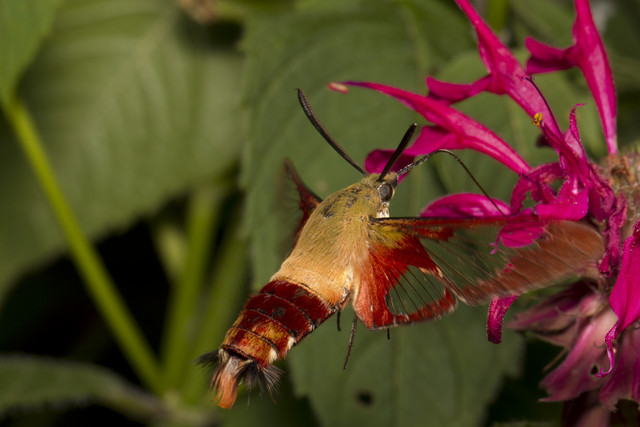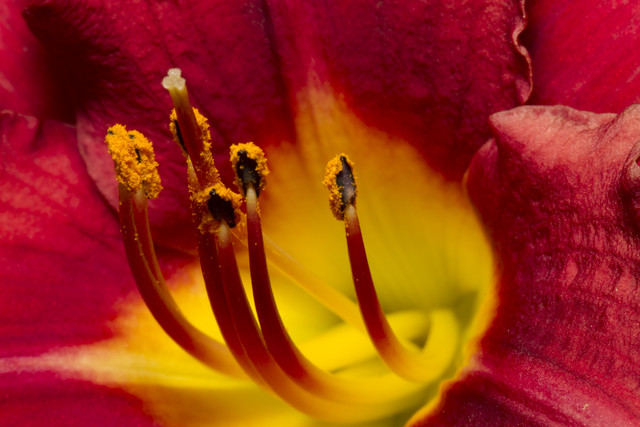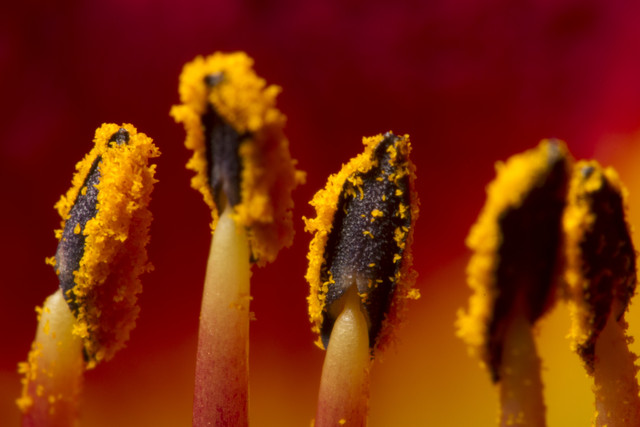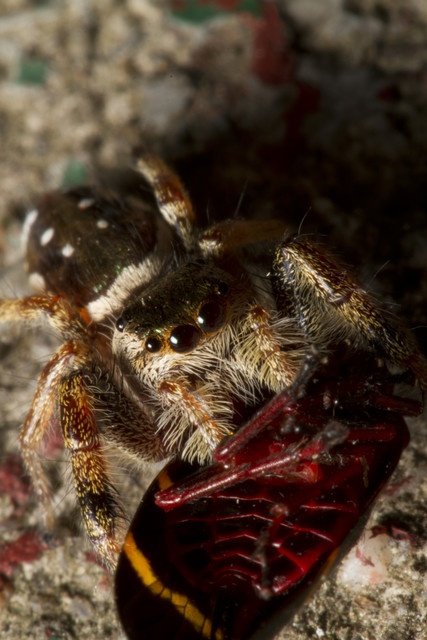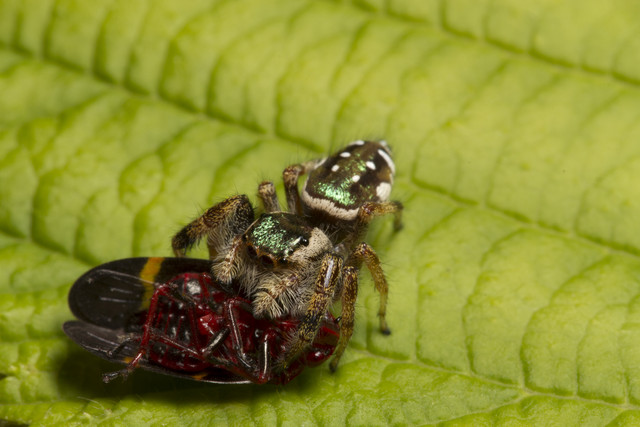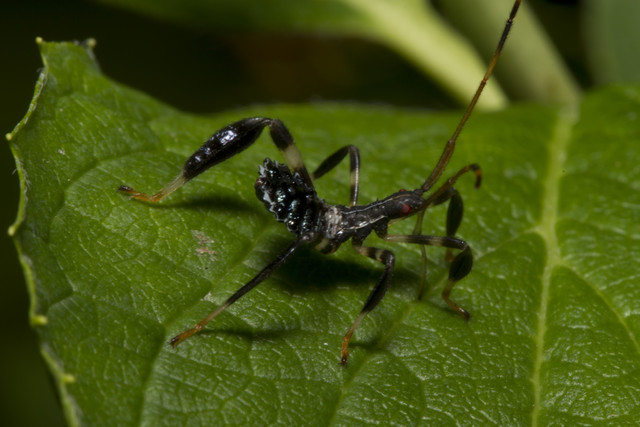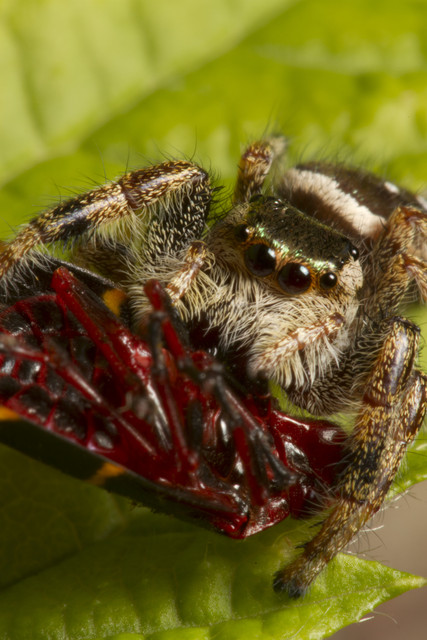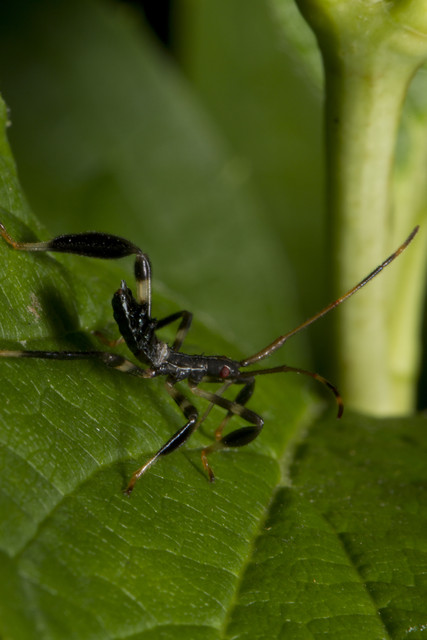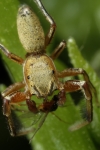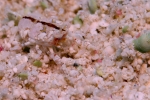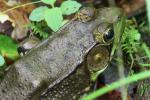flash
Hummingbird Moth (part 1)
ktuli — Tue, 07/19/2011 - 19:43
Ok - a slight bounce back to the bugs today. I have another day of flower photos to do, but it is a much more in-depth post with discussion of apertures and depth of field, so I want to take my time with it and hopefully make it clear to understand and useful for folks.
So instead, you get a sneak peak at a hummingbird moth photo.
Technical Data: Canon EOS 7D, Canon EF 100mm f/2.8L Macro IS USM, 1/250 sec at f/16. Canon Speedlight 580EX II flash in auto mode and wireless control. Image Stabilization on. ISO 160. RAW processing in Adobe Camera Raw.
Did you do the double take? Did you think that was a hummingbird? Look again... notice the antennae and the extra legs?
I'll tell you more about hummingbird moths in a few days. Stay tuned.
- Bill
Day Lily Pollen Stamens
ktuli — Mon, 07/18/2011 - 20:33
Ok - as promised - a short break from the spiders.... The other day as I looked around for more creepy-crawlies to shoot, I turned my attention to some of the day lilies in our yard and took some shots focusing on their pollen stamens.
Technical Data: Canon EOS 7D, Canon EF 100mm f/2.8L Macro IS USM with Kenko Teleplus PRO 300 "DG" AF 2x Teleconverter, 1/250 sec at f/16. Canon Speedlight 580EX II flash in auto mode and wireless control. Image Stabilization on. ISO 160. RAW processing in Adobe Camera Raw.
And some getting really up close and personal with the pollen in an exercise in super-macro....
Technical Data: Canon EOS 7D, Canon EF 100mm f/2.8L Macro IS USM with Kenko Teleplus PRO 300 "DG" AF 2x Teleconverter, 1/250 sec at f/16. Canon Speedlight 580EX II flash in auto mode and wireless control. Image Stabilization on. ISO 160. RAW processing in Adobe Camera Raw.
Hope this helps counter balance the week of spider shots, but I have more spiders to share soon, so probably not... (sorry!)
- Bill
Skull-Faced Jumping Spider
ktuli — Sun, 07/17/2011 - 18:24
Ok - I know... that title alone is enough to turn anyone away from this post, but this spider really does look like he has a skull on his face - it is uncanny. Plus, I promise to take a little break from the spiders after today. I have more shots to share of this guy, but I'm going to spread them out a bit and switch back to some flowers and some other bugs (including a hummingbird hawk moth!) over the coming days.
But check this guy out...
Technical Data: Canon EOS 7D, Canon EF 100mm f/2.8L Macro IS USM, 1/250 sec at f/16. Canon Speedlight 580EX II flash in auto mode and wireless control. Image Stabilization on. ISO 160. RAW processing in Adobe Camera Raw.
Going to skip the discussion for now... I've got a bunch of photos to process so I have other stuff than spiders to share... ;)
Thanks for stopping in.
- Bill
Jumping Spider Dinner (part 4)
ktuli — Thu, 07/14/2011 - 17:31
OK - just an assortment to finish up with this jumping spider (sorry - still haven't been able to ID it).
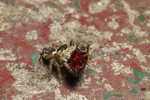 |
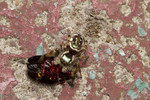 |
 |
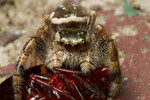 |
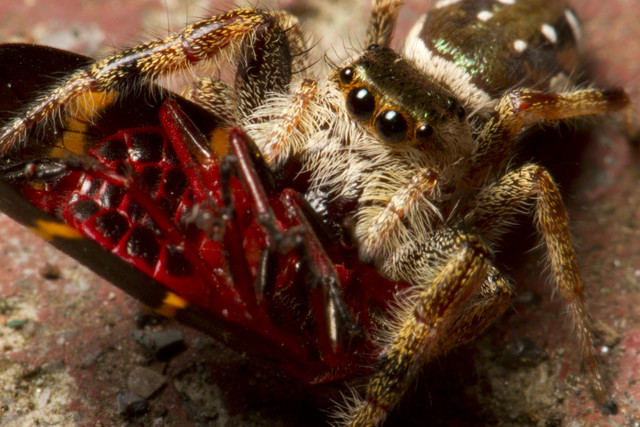 |
|||
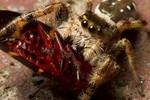 |
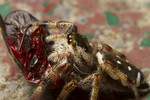 |
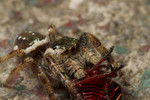 |
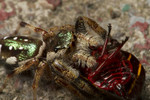 |
Technical Data: Canon EOS 7D, Canon EF 100mm f/2.8L Macro IS USM with Kenko Teleplus PRO 300 "DG" AF 2x Teleconverter (except first 2), 1/250 sec at f/16. Canon Speedlight 580EX II flash in auto mode and wireless control. Image Stabilization on. ISO 160. RAW processing in Adobe Camera Raw.
Thanks for looking. And don't forget to go vote on the post here!
- Bill
Poll: Jumping Spider Dinner (part 3)
ktuli — Wed, 07/13/2011 - 19:37
As I was working with this guy, I was trying many different angles - some because he would move around, some because I just wanted to get as many angles as possible before he got tired of having a camera shoved in his face.
When I tried this angle, my camera flash bracket put the flash to the side of the spider. I could have moved it, but then I thought about how a shot would look with the light coming from the side and producing this strong shadow on the other side of the spider.
Fortunately, it worked exactly as I had envisioned before clicking the shutter. The side lighting caused a very distinct shadow to the far side of the spider - producing an effect that makes the spider look much larger than he really is. In truth, because of the setup I was using (basically a 2:1 magnification), this spider was already looking pretty giant in the viewfinder. However, that big shadow just increases that feeling in my opinion.
I shared this on a forum I frequent, and received lack-luster responses to the usage of the flash in this manner. One suggestion was to use a reflector to bounce some of the flash light back into the right side. This probably would have still kept the distinct shadow, but would have helped to bring back some of the details on the right side of the spider.
I don't know if that would have really done much, or if I would have liked it better - I personally am very pleased with this shot and the feeling it produces for me.
Technical Data: Canon EOS 7D, Canon EF 100mm f/2.8L Macro IS USM with Kenko Teleplus PRO 300 "DG" AF 2x Teleconverter, 1/250 sec at f/16. Canon Speedlight 580EX II flash in auto mode and wireless control. Image Stabilization on. ISO 160. RAW processing in Adobe Camera Raw.
So cast your vote and let me know what you think... whether the strong shadow works, or if it ruins the image. Drop me a comment and let me know why you voted the way you did (sorry - no option will be provided for 'the spider ruined the image, not the shadow!'). Remember - you don't have to know all about photography to be able to vote on what you like...
Thanks for stopping by!
- Bill
Jumping Spider Dinner (part 2)
ktuli — Tue, 07/12/2011 - 19:06
Here's another of that jumping spider with his dinner. This one was taken without the teleconverter, so the magnification isn't as dramatic, but I feel this shot has a bit better composition than just a super-macro shot.
Technical Data: Canon EOS 7D, Canon EF 100mm f/2.8L Macro IS USM, 1/250 sec at f/16. Canon Speedlight 580EX II flash in auto mode and wireless control. Image Stabilization on. ISO 160. RAW processing in Adobe Camera Raw.
Why This Photo: When I found this little guy digging into his dinner, and saw what a cool jumping spider he was, I simply had to see what kind of shots I could manage with him.
What Works: The best item of this shot is the way the metallic green color shows up on the spider's body. This color only appeared on certain angles, so I did have to make some sacrifices to get it, but I think it was worth it. The DoF works to get almost the whole spider in clarity (only possible because of the light provided by the 580EX), and the focus is sharp right on the spider's face. And the bright green leaf produces a nice pleasing background.
What Doesn't Work: To get the green metallic color, I had to sacrifice getting the spider's face and eye contact (many of the other shots have great catchlights in the eyes). Also, the composition would probably have been better if the spider were in the upper right corner, but that simply depended on where the spider was on the leaf (in fact, the edge of the leaf shows in the very bottom left corner).
What do you think? Drop me a comment and let me know.
- Bill
Assassin Bug (part 2)
ktuli — Sun, 07/10/2011 - 17:23
As promised, here are a couple more shots of the ninja assassin bug (ok - that's not a technical name, but it sure looks like a ninja!).
Technical Data: Canon EOS 7D, Canon EF 100mm f/2.8L Macro IS USM with Kenko Teleplus PRO 300 "DG" AF 2x Teleconverter, 1/250 sec at f/22. Canon Speedlight 580EX II flash in auto mode and wireless control. Image Stabilization on. ISO 160. RAW processing in Adobe Camera Raw.
This first one was actually taken inside the light tent. I had trapped the bug in a small tupperware container and transported it to our light tent hoping to get some shots of it on a nice white background. Unfortunately, I think the bright lights really bothered it and it would not sit still for very long. I managed to get a few shots, but more of the time was spent trying to keep it from running away. After a bit, I decided that it was just far too stressed by the ordeal and transferred it back outside.
Fortunately, once it was out of the bright lights and back on a plant outside, it sat still very nicely. Unfortunately, it was 10PM at night, and already very dark outside. So capturing images of it was a challenge. Particularly, focusing was extremely difficult. I had to almost guess at the focus - using the outline of the bug against whatever light source I could find.
In the end, I was able to get a couple shots including the one I shared the other day and this one:
Technical Data: Canon EOS 7D, Canon EF 100mm f/2.8L Macro IS USM, 1/250 sec at f/22. Canon Speedlight 580EX II flash in auto mode and wireless control. Image Stabilization on. ISO 160. RAW processing in Adobe Camera Raw.
I was really glad that I was able to get some good shots of such an interesting subject - despite the difficulties presented.
- Bill
Jumping Spider Dinner (part 1)
ktuli — Sun, 07/10/2011 - 15:36
Ok - I am sorry to start another multi-part series right after beginning a different oe, but I found this little guy last night and really want to start sharing the photos. So I promise to get back to the assassin bug, but it will just be interspersed with this jumping spider.
I found this guy on a leaf on one of the plants out front. Because of where he was located, I simply decided to pinch off the leaf he was on and relocate him to the floor of our front porch. He had obviously just captured this insect (the legs were still twitching) he was starting to tuck into, so I wanted to be careful not to cause him to lose his meal. Apparently there was little risk of that. Over the twenty minutes or so that I was photographing him, he never once let go of it, and probably didn't ever stop eating (by the end, the bug was much smaller and shriveled).
As if typical for me these days, I shot these using the Speedlight 580EX II on a Siegelight bracket and Lumiquest Mini-Softbox and controlled wirelessly by the Canon 7D and my new favorite lens in the Canon EF 100mm f/2.8L Macro, and after a few initial shots with that setup - I usually toss in the Kenko 2x teleconverter. All told, the setup allows me to get shots that I never would have imagined possible before. The Canon 100mm lens provided some excellent image quality, and the image stabilization helps to let me shoot handheld (which I probably shouldn't do), while the flash allows me to stop down the aperture (often to f/16 or higher) for greater depth of field, and finally the teleconverter allows me get 2:1 (twice life-size) magnification.
What that all translates to is getting to see the culinary habits of jumping spiders in incredible detail - though I am sure there are those of you who don't think that is a good thing, but oh well. :)
Technical Data: Canon EOS 7D, Canon EF 100mm f/2.8L Macro IS USM with Kenko Teleplus PRO 300 "DG" AF 2x Teleconverter, 1/250 sec at f/16. Canon Speedlight 580EX II flash in auto mode and wireless control. Image Stabilization on. ISO 160. RAW processing in Adobe Camera Raw.
Stay tuned and I'll continue sharing shots of the assassin bug and this jumping spider.
- Bill
Assassin Bug (part 1)
ktuli — Fri, 07/08/2011 - 07:24
Ok - just a quick post because I want to share this... I found this guy yesterday and had to get a couple photos of him. I had found a larger one a couple weeks ago, but wasn't able to get any photos.
This is an assassin bug - I believe a sub-adult.
Technical Data: Canon EOS 7D, Canon EF 100mm f/2.8L Macro IS USM, 1/250 sec at f/22. Canon Speedlight 580EX II flash in auto mode and wireless control. Image Stabilization on. ISO 160. RAW processing in Adobe Camera Raw.
I will share more about assassin bugs and their behaviors as well as the challenges I faced taking these photos at a later time.
Thanks for stopping by.
- Bill
Jumping Spider Web
ktuli — Wed, 07/06/2011 - 19:18
So I didn't realize that some jumping spiders actually build themselves a web. I'm not sure what the purpose of this little spider's web is - whether it is for trapping food, or just protection overnight, or for laying eggs. But I sat and watched this little spider spin this web for about fifteen minutes the one evening (and then I forgot this photo was still sitting on the card)
Technical Data: Canon EOS 7D, Canon EF 100mm f/2.8L Macro IS USM, 1/250 sec at f/16. Canon Speedlight 580EX II flash in auto mode and wireless control. Image Stabilization on. ISO 160. RAW processing in Adobe Camera Raw.
Sorry I have been lazy with posting recently... just been having a hard time keeping myself motivated, and I've been trying to get outside every once in a while and enjoy the weather and get some exercise. I don't know if I'll pick up with regular posts again any time soon or not, so I'm not going to make any promises.
Thanks for stopping by.
- Bill

